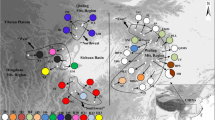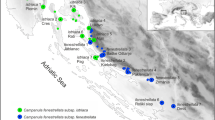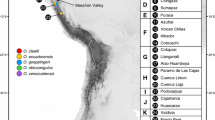Abstract
We used sequence variation of the atpB-rbcL intergenic spacer of cpDNA and nested clade analysis to assess the phylogeographic pattern of Michelia formosana, a species restricted to Taiwan and the Ryukyus. In total, 31 haplotypes were identified and clustered into four major chlorotypes. Genetic composition of nearly all populations was heterogeneous and paraphyletic phylogenetically. Although the apportionment of cpDNA variation hardly revealed a geographic pattern due to the coancestry of dominant sequences, some chlorotypes were restrictedly distributed. According to the patterns of clade dispersion and displacement, a reconstructed minimum spanning network revealed that historical events of past fragmentation and range expansion, associated with glaciation, may have shaped the phylogeographic patterns of M. formosana. Four possible refugia were identified: the Iriomote and Ishigaki Islands (the southern Ryukyus), Wulai (northern Taiwan), and Nanjen (southern Taiwan), on the basis of the interior positions of their haplotypes in the network and the high level of nucleotide diversity. Given insufficient time for coalescence at the cpDNA locus since the late Pleistocene recolonization, lineage sorting led to low levels of genetic differentiation among populations. In contrast, hierarchical examination of the random amplified polymorphic DNA (RAPD) data scored from six populations across three geographical regions, using an analysis of molecular variance (AMOVA), indicated high genetic differentiation both among populations (ΦST = 0.471) and among regions (ΦCT = 0.368). An unweighted pair group method with arithmetic mean (UPGMA) tree of the RAPD fingerprints revealed that populations of two offshore islands of eastern Taiwan (M. formosana var. kotoensis) were clustered with geographically remote populations of the Ryukyus instead of those in southern Taiwan, suggesting some historical division due to geographic barriers of the central mountain range. In contrast to the paraphyly of the nearly neutral cpDNA alleles, differentiated RAPDs may have experienced diversifying selection.
Similar content being viewed by others
Author information
Authors and Affiliations
Additional information
Received: July 2, 2001 / Accepted: February 20, 2002
Rights and permissions
About this article
Cite this article
Lu, SY., Hong, KH., Liu, SL. et al. Genetic variation and population differentiation of Michelia formosana (Magnoliaceae) based on cpDNA variation and RAPD fingerprints: relevance to post-Pleistocene recolonization. J Plant Res 115, 0203–0216 (2002). https://doi.org/10.1007/s102650200026
Issue Date:
DOI: https://doi.org/10.1007/s102650200026




